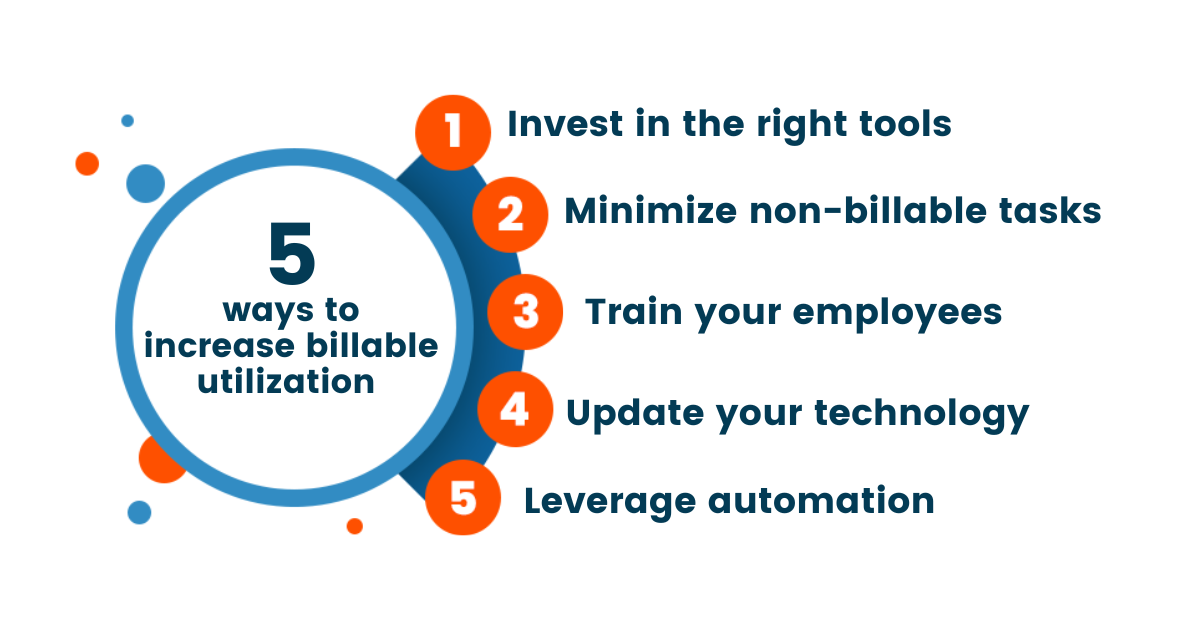
As a business owner, you already operate on tight margins and limited resources. So, it’s vital to optimise your existing resources and maximise profits by cutting losses and inefficiencies.
This is where calculating, tracking, and improving your billable utilisation comes in.
If you’re not familiar with this term, it’s simply a measure of how much time your employees are spending on work that directly generates revenue. Improving billable utilisation can increase your company’s overall efficiency and help you generate more revenue without investing additional resources.
In this article, we’ll explain billable utilisation in detail and show you ways to improve it for your business.
What is billable utilisation, and why is it important?
Billable utilisation is the percentage of time your employees and team members spend on work that generates revenue. You can calculate it across your team and for individual employees.
In other words, an employee’s billable utilisation score shows how much of their total working time is spent on work that produces business results that earn revenue.
A high billable utilisation percentage shows you’re using your resources efficiently and investing your time in the most critical projects. A low billable utilisation score, on the other hand, means you must optimise your processes and reassess your resource plans with capacity planning.
For example, say a marketing agency hires an expensive copywriter to work on a new project. They’d want to maximise the billable utilisation of the copywriter by ensuring they work on billable, client projects only.
But if the copywriter spends a large chunk of their time in meetings, dealing with bottlenecks or technical tasks like configuring a landing page tool or installing WordPress, their billable hours will decrease because the agency cannot charge the client for those hours.
So, the agency must ensure that out of the copywriter’s total available working hours, little to no available time is spent on work outside the copywriting process.
The benefits of measuring billable utilisation
Knowing your team’s billable utilisation has several benefits. By tracking this metric, you can:
- Compare your efficiency and functionality against industry benchmarks and make adjustments
- Ensures the right resources are allocated for the right jobs
- Increase profitability without investing additional resources
- Get a clear picture of your resource capacity to take on future projects
- Inform your project planning and resource allocation for billable projects
What’s a good billable utilisation rate?
One hundred percent billable utilisation isn’t possible or desirable. Even your most efficient employees need time for training, skill development, and administrative tasks that are not directly billable. The ideal score also varies with the nature of work, as some roles are more suited to direct billing than others.
Generally, a professional service-based company should aim for a billable rate above 80 percent. However, every industry has different benchmarks, so it’s essential to see the score in the context of your particular industry.
If your scores are below the industry benchmark, you’re underutilising your available resources and must optimise your billable utilisation. On the other hand, if you’re significantly ahead of the average industry numbers, you’re overutilising your resources, which might result in burnout and reduce employee productivity and efficiency in the long run.
Billable utilisation vs. resource utilisation
Although these two terms are commonly confused, they convey different aspects of your business. Resource utilisation represents all the tasks and activities of your team, including non-billable hours. Billable utilisation is a more specific metric representing the percentage of time your team spends on billable tasks and activities.
How to calculate billable utilisation
Calculating billable utilisation is pretty straightforward. You take the total number of billable hours and divide it by the total available hours, excluding things like holidays and non-billable activities.
This percentage is then multiplied by 100 to get your billable utilisation rate.
Billable utilisation = (billable hours / total available hours) x 100
For example, if your business has 1,200 billable hours a year and your total available hours (minus holidays) are 2,000, your billable utilisation would be (1,200 / 2,000) x 100 = 60 percent.
You can use the same formula to calculate the utilisation of individual employees.
How to track billable hours
The most reliable way to track billable hours is by using a centralised and fully automated time-tracking system that logs your team’s activities, manages comprehensive timesheets, and gives you a clear picture of their daily activities.
The challenge, of course, is to ensure that everyone on the team records their time honestly and regularly.
Here are a few tips to make that happen:
- Explain the benefits of time tracking to your team and how it helps your business become more efficient.
- Clarify how logging everything helps highlight your team’s performance.
- Make time tracking effortless and hassle-free.
- Share reminders.
- Run daily or weekly audits on different levels to ensure your team logs working hours and daily tasks.
5 ways to increase billable utilisation rate for your business

Continually optimising your billable utilisation is among the best ways to increase profitability and accelerate business growth.
Here’s how to do it.
1. Invest in project management and CRM tools
You need an integrated project management system that not only tracks time but also gives you a 360-degree view of your projects and their allocated resources.
By connecting it with a CRM system like Act! you can gain additional visibility across your sales and marketing pipelines, enabling you to plan your workload and resource availability more efficiently.
Combining your CRM with your resource management system shows you:
- Your team’s total available hours
- Current billable time and utility
- Sales and marketing leads that are ready to onboard for the next month or quarter
- Individual team members with high or low utility scores.
Such transparency and real-time insights simplify your decision-making and help you increase efficiency.
2. Shift or minimise non-billable tasks
Carefully evaluate your team’s workload to ensure they’re not unnecessarily involved in any non-billable tasks. Optimise their billable utility by shifting unproductive tasks to cheaper resources and minimising distractions that hurt productivity.
3. Train and upskill your employees
Sometimes, the easiest way to increase billable efficiency is by investing in your team’s training and development. With timely skill set upgrades, they can perform the same tasks with greater efficiency, resulting in higher profitability.
4. Upgrade your technology
Evaluate your business equipment and technology to ensure they’re in optimal condition and do not cause operational delays. If you see the need, invest in more advanced technology to help your team perform the same tasks in less time.
5. Leverage automation
Every business must evaluate the tasks and operations they can automate. This can free up your resources, increase efficiency, and help you drive better results with fewer resources.
For example, Act! can automate your sales, support, and marketing workflows through tools like automated landing pages, email campaigns, and lead scoring.
Optimising billable hours is low-hanging fruit for SMBs
SMBs don’t always have the liquidity to invest in business growth. Optimising billable hours is an excellent way to increase profitability without major expenses. By using an integrated resource management system coupled with a CRM like Act! you can get all the information you need to calculate, track, and increase your billable work, resulting in greater efficiency and growth.
Sign up for your free Act! trial and see it in action.






